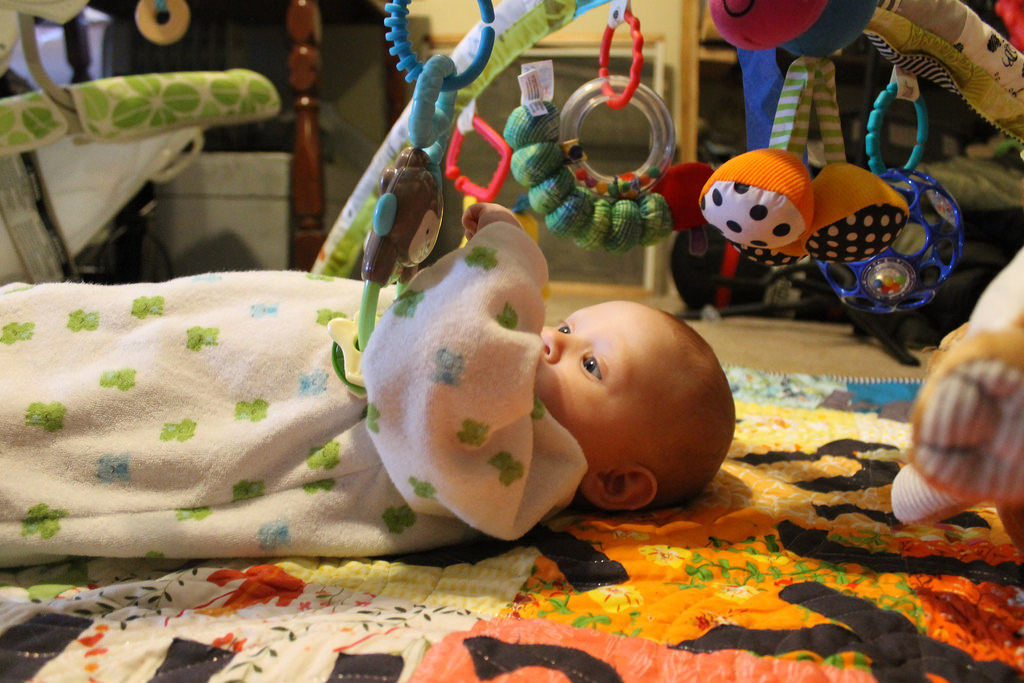Have you ever wondered what the world looks like through your baby’s eyes? From birth, your infant is able to explore the wonders of the world through sight. But at this point, your baby’s vision is pretty fuzzy. He or she can see just far enough away to make out your face when you are holding them.
Gif of baby eye development from birth to one year //source: Clinic Compare
Although your infant’s eyes are capable of seeing at birth, his or her brain is not yet ready to process and interpret this information. During your baby’s first few years, they are much more sensitive to visual input and environmental stimulation. This is known as a critical period. This is an important time for your infant because if this ability is not stimulated, it will be lost. As your newborn begins to see, they are constantly provided with new and interesting information. Your baby’s eyes transmit this new information to their brain, and connections begin to form between brain cells, or neurons, in the area of their brain responsible for vision. With time and continued visual input, your baby learns to process this information into images.
Although every baby is different and reaches developmental milestones at different times, you may notice your infant’s vision starting to develop throughout their first few months. Around one to two months, your baby’s eyes should start working together as a team. They should be better able at focusing both eyes on objects, and you can start making eye contact with your baby. He or she will also be able to track a moving object, where for example, your baby might gaze at a rattle being moved across his or her field of view.
Despite common misconception, your baby can see color from birth, just not as vividly as adults. Newborns have difficulty distinguishing between similar tones, which is why they prefer black and white or high contrast patterns. Around two to four months, your baby’s color vision improves greatly. They are starting to be able to distinguish between colors of similar shades, such as red and orange. Your baby will probably show a preference for brighter shades of colors, which is why you may notice that baby toys are so brightly colored!

As your baby develops, they will start to see and recognize your faces, their toys, and all of the wonderful moments and experiences you share together. Your baby will become fascinated with visual stimulation, so you may find it helpful to encourage this! Your baby will learn how to use the visual information around them to guide their later development.
Supplementary Material
For additional information and resources, take a look at the following.
1. Interested in learning more about how your baby learns to see? Here is a helpful article from the American Optometric Association discussing some milestones for your infant’s vision development and ways you could help their vision develop properly.
2. Babysee is an app that allows you to see as your infant does! Scientists from Boston Children’s Hospital developed this infant vision simulator that may help you understand how your infant sees and how their vision develops over time. Learn more here.
3. Over time, your baby is learning to focus their eyes and starting to better distinguish color. To help your baby’s vision develop, check out this article from the American Optometric Association for fun toy and game ideas!
4. Pawan Sinha gave this very interesting TED Talk on how the development of the brain’s visual system. He describes his research with and vision-restoring treatment for children born blind, as well as implications in engineering and the clinical world.
References
Aslin, R.N., (1977). Development of binocular fixation in human infants. Journal of Experimental Child Psychology, 23, 133-150.
Aslin, R. N., & Banks, M. S., (1978). Early visual experience in humans: Evidence for a critical period in the development of binocular vision. In Psychology From Research to Practice (pp. 227-239). New York, NY: Plenum Press.
Browne, A. M., (1990). Development of visual sensitivity to light and color vision in human infants: A critical review. Vision Res, 30(8), 1159-1188.
Johnson, S. P. (2013). Development of the Visual System. In Comprehensive Developmental Neuroscience: Neural Circuit Development and Function in the Brain (Vol. 3, pp. 249-269). Elsevier Inc.
Mayes, L. C. & Cohen, D. J. (2002). The Yale Child Study Center Guide to Understanding Your Child: Healthy Development from Birth to Adolescence. Boston: Little, Brown, and Company.